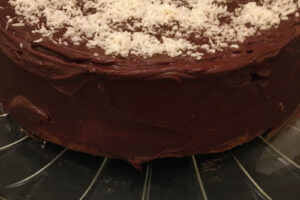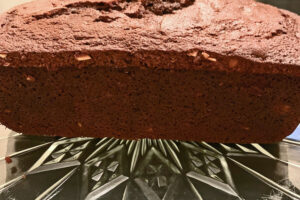Cassata Siciliana is the extravagant cake that is traditional, especially around Easter, in Sicily. At many venues in Palermo, however, you may find the cake featured year-round. For example, at Anitico Caffe Spinnato or at the Bisso Bistrot where it is their signature dessert.
The cake has as many variations as there are imaginations. Generally, it includes a spongecake, candied fruit, a sweetened ricotta filling (think cannoli filling), chocolate, marzipan, and a sweet icing or glaze, decorated with more fruit. It’s a very sweet and heavy concoction.
In my own creation of it, I’ve tried to make a lighter and slightly less sweet version, more to contemporary tastes, by eliminating the marzipan, cutting down on the sugar, using bittersweet chocolate, and lightening the ricotta with whipped cream. Still, it will titillate even the sweetest tooth.
For the Spongecake
Preheat oven to 350°. Butter and flour an 9-inch cake pan. In a large bowl, beat 5 egg yolks, the lemon zest, and lemon juice until thickened.

Beat yolks with sugar, lemon juice, and zest.
Gradually beat in 1/2 cup of sugar, and continue to beat until the mixture forms a slowly dissolving ribbon.

Beat until a ribbon is formed.
Beat 5 egg whites until foamy and sprinkle on the cream of tartar. Continue to beat until soft peaks are formed. Gradually beat in 1/4 cup of sugar until stiff peaks are formed.

Beat egg whites and sugar until stiff.
Stir in 1/3 of the beaten egg whites into the yolk mixture with a rubber spatula.

Fold egg whites in yolk batter.
Sprinkle 1/3 of the flour through a sieve into the batter and fold in carefully. Fold in the remaining 2/3 egg whites and flour, alternately by thirds.

Fold in flour.
Pour the batter into the prepared cake pan and bake in the middle level of the oven for about 30-35 minutes. When a cake tester comes out clean, remove the cake to a wire rack, and let cool for ten minutes. Run a knife carefully around the edges, and invert onto the rack. Let cool completely.

The baked spongecake.
The cake maybe made a day or two ahead of time and frozen in a plastic bag. When ready to assemble, cut into three even layers.
For the Fillings
Place 1 pound of whole-milk ricotta in a paper-towel-lined sieve over a bowl to drain any liquid. (Whole-milk ricotta is essential here.) Cover with plastic wrap and refrigerate for a few hours or overnight.

Drain ricotta in a sieve.
Put the drained ricotta in the bowl of a food processor with the vanilla extract, and process until smooth. Place 1/3 cup powdered sugar in a sieve over the food-processor bowl, and sift into the ricotta.

Sift powdered sugar into ricotta.
Process again until the sugar is fully incorporated. Scrape into a bowl and refrigerate.

The ricotta cream filling.
Whip the heavy cream in a chilled bowl until firm peaks are formed. Blend 1⁄3 of the whipped cream into the ricotta mixture, then gently fold in the remaining cream.

Fold whipped cream into ricotta filling.
Remove half the mixture to another bowl. Fold in 1/4 cup of chocolate chips and 1/4 cup candied orange peel into one bowl of ricotta filling.

Fold in chocolate chips and candied orange peel.
Fold in 1/4 cup chopped pistachios and 1/4 cup candied pineapple into the other bowl of ricotta filling.

Fold in candied pineapple and pistachios.
Place both bowls in the refrigerator while you continue.
Note: For this Cassata Siciliana recipe I use only candied orange and pineapple for the filling, but you can substitute whichever candied fruits you prefer. High-quality candied fruits can be obtained from Paradise Fruit Company.

Paradise Fruit Company.
For the Syrup
Place the sugar and water in a small, heavy saucepan, and mix thoroughly. Place over medium heat, and bring to a boil, stirring occasionally, and washing down any sugar crystals that have formed on the side of the pan, with a wet pastry brush. Allow the syrup to fully cool, then stir in the Grand Marnier to taste.
Molding the Dessert
Rub 1 tablespoon of vegetable or other flavorless oil in the same pan in which you baked the cake. Slice the cake into three even layers.

Slice the cake into 3 layers.
Fit the bottom layer, bottom side down into the pan. (This will become the top layer of the dessert.) Brush the layer with the syrup.

Brush the cake layer with Grand Marnier syrup.
Spread one of the ricotta mixtures over the bottom cake layer.

Spread the chocolate-orange mixture over one layer.
Brush both sides of the middle cake layer with the syrup, and press onto the ricotta mixture in the cake pan. Spread the second ricotta mixture over middle cake layer.

Spread pineapple-pistachio mixture over second layer.
Brush the cut side of the top cake layer with syrup and press onto that ricotta mixture.

Press the top layer into the cake pan.
Cover the Cassata Siciliana with plastic wrap, and refrigerate for several hours or overnight.
Unmolding the Cake
Remove the Cassata from the refrigerator, and run a thin-bladed knife carefully around the edge. Fill the sink with about an inch of hot water. Submerge the cake pan in the hot water for a few seconds to help loosen it, then invert the cake onto the center of a serving plate. Refrigerate the cake while you prepare the icing.
Icing the Cake and Decorating the Cassata Siciliana
Sift the powdered sugar into a heavy saucepan to eliminate any lumps.

Sift powdered sugar for the glaze.
Stir in the strained lemon juice into the sugar, then by tablespoons stir in the water until you get a glaze that’s not too runny, but can still be poured from the pan. Place the pan over low heat, stirring constantly until the sugar is dissolved. You may have to adjust with more water or powdered sugar to attain the right consistency.

Heat sugar, water and lemon juice.
Working quickly before the glaze sets, pour it over the cake, smoothing the top until it achieves a fine sheen. Let the glaze run over the sides, but it’s almost impossible to smooth out the glaze on the sides of the cake. Chill the cake for one hour. My version of Cassata Siciliana is featured in the Paradise Fruit Company website: click here.
Decorate the top of the Cassata with pieces of candied fruit and whole pistachios.

Frost and decorate the top of the cake.
Keep refrigerated until serving time.






